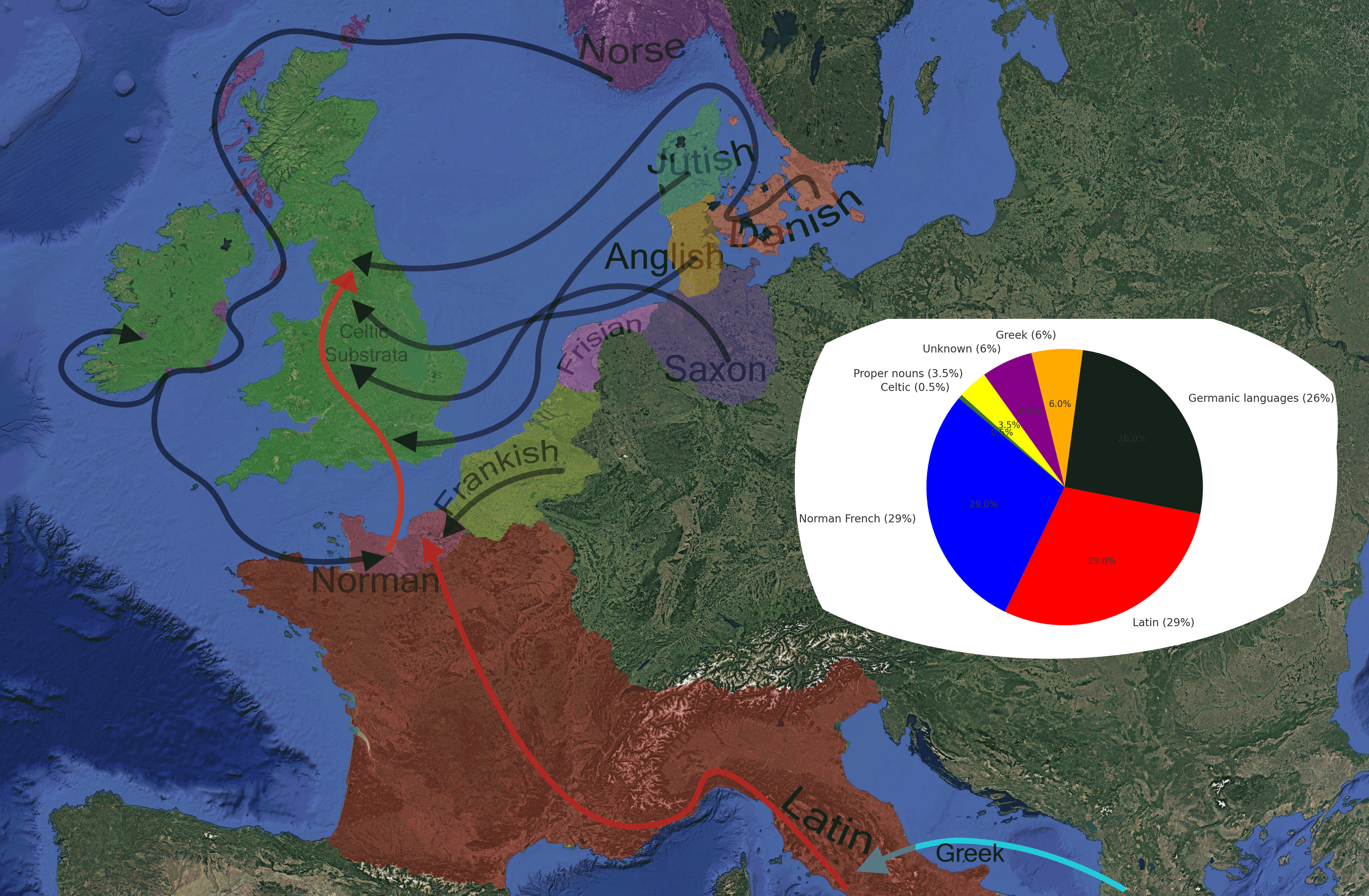Vocabulary Origins Map of English Contributions


Marcus Rodriguez
Historical Geography Expert
Marcus Rodriguez specializes in historical cartography and geographic data analysis. With a background in both history and geography, he brings unique...
Geographic Analysis
What This Map Shows
The visualization titled "Linguistic Contributions to English and A Pie Chart of Vocabulary Origins" provides a detailed breakdown of the diverse linguistic influences that have shaped the English language over centuries. By illustrating the various sources of vocabulary—such as Latin, French, Germanic roots, and more—this map highlights not only the etymological layers of English but also reflects the historical interactions and cultural exchanges that have enriched the language.
Deep Dive into Vocabulary Origins
Ever wondered why English feels like a melting pot of languages? This phenomenon can be traced back to the intricate history of England itself. The English language primarily stems from three significant sources: Old English (Anglo-Saxon), Norman French, and Latin. Each of these linguistic families has contributed to the vocabulary we use today, creating a rich tapestry of words that often have overlapping meanings but distinct connotations.
Old English, which evolved from Germanic tribes that settled in England around the 5th century, forms the foundation of the language. It accounts for about 26% of modern English vocabulary. Words like "house," "man," and "child" stem from this Germanic heritage. However, the Norman Conquest of 1066 brought a significant influx of French vocabulary. With the Normans in power, many French words entered English, particularly in the realms of law, art, and fashion. This contribution amounts to nearly 29% of English vocabulary. For instance, terms like "jury," "court," and "beauty" all derive from French.
Interestingly, Latin has also played a crucial role in shaping English, particularly during the Renaissance when scholars revived interest in classical languages. Latin words account for around 29% of English vocabulary, especially in scientific, medical, and religious contexts. Words like "science," "religion," and "data" are prime examples of Latin's lasting impact.
Moreover, other languages have influenced English too, particularly through trade, colonization, and immigration. Words from Spanish, Italian, and even indigenous languages can be found scattered throughout. For instance, terms like "taco," "opera," and "kayak" illustrate how English continues to evolve and absorb new influences.
Regional Analysis
When examining the map, distinct regional influences emerge. In the United Kingdom, the legacy of Old English remains strong, particularly in rural areas where traditional dialects persist. In urban centers like London, the impact of multiculturalism is evident, with words from Caribbean, South Asian, and Arabic cultures enriching the local vernacular.
In the United States, the vocabulary is heavily influenced by immigration waves. For instance, Spanish words are prevalent in states like California and Texas, thanks to historical ties with Mexico. Similarly, Italian and Irish influences are notable in cities like New York and Chicago, where immigrant communities have left a lasting imprint on the local dialect.
Interestingly, the increasing use of technology and social media has also led to the emergence of new vocabulary influenced by global culture. Terms like "selfie" and "hashtag" are prime examples of how language evolves rapidly in response to societal changes, showcasing the dynamic nature of English vocabulary across different regions.
Significance and Impact
Understanding the origins of English vocabulary is not merely an academic exercise; it has real-world implications. Language shapes identity, culture, and societal norms. As globalization continues to weave interconnectedness into our lives, the English language is increasingly becoming a global lingua franca, bridging communication gaps across cultures.
Current trends suggest that English will continue to evolve, absorbing new words and phrases from diverse languages. This ongoing transformation reflects societal changes, technological advancements, and cultural exchanges. As we move forward, the map serves as a reminder of the rich, multifaceted history of English, illustrating how language is a living entity that adapts to the environment and influences around it. In a world that is becoming more interconnected, the vocabulary we choose to use will play a critical role in shaping our collective future.
Language, after all, is not just a tool for communication; it is a vessel for culture, history, and human experience. As we navigate through the complexities of modern life, recognizing the significance of these linguistic contributions can foster greater understanding and appreciation of the diverse world we inhabit.
Visualization Details
- Published
- September 23, 2025
- Views
- 60
Comments
Loading comments...